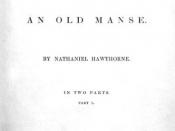Ultimately in life each person goes through the process of the demise of innocence, because evil is omnipresent. Everyone has a shadow side to himself. Nathaniel Hawthorne's short story "Young Goodman Brown" displays a protagonist's archetypal journey to the discovery of evil in mankind. Hawthorne's use of the threshold motif depicts the archetypal struggle between good and evil and the inevitable loss of innocence. Set in the Puritan age, Goodman Brown embarks on a voyage into the dark forest where he uncovers the evil in everyday society. Prophetically, Goodman Brown begins his trip at sunset in the streets of Salem, Massachusetts. Hawthorne's didactic narrative exemplifies loss of innocence through the use of archetypal motifs, symbols, and imagery.
The commencement of Goodman Brown's archetypal quest demonstrates the beginning of a journey that may lead to jeopardy and Goodman Brown's loss of innocence. This quote from the beginning of the narrative is an example of Hawthorne's threshold motif, "Young Goodman Brown came forth at sunset into the street at Salem Village; but put his head back, after crossing the threshold, to exchange a parting kiss with his young wife" (Hawthorne 1).
Goodman Brown is about to start a journey from his house, which represents safety, into the streets of Salem, which symbolize danger; also, it shows that Brown's faith is on the line because he steps into danger then back to safety to kiss his wife, "Faith," and then steps back to danger. His wife's name is Faith; so, she represents Brown's faith, and she wears pink ribbons, which represent innocence. Since Goodman Brown is leaving his wife, it shows that he is going to lose his innocence sometime during his archetypal journey. Another threshold motif is when Goodman Brown enters the forest, which will ultimately lead to loss...


